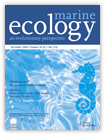Seasonality of Competition in Early Development of Subtidal Encrusting Communities
Abstract
Abstract. Settlement panels immersed at Lough Hyne, County Cork, Ireland, at six stations with widely different flow regimes were retrieved at monthly intervals. Between 40 and 62 taxa were identified at each station during the study period. Percentage cover, number of interactions and number of recruits were recorded. Space occupied was found to vary more than 2.5 orders of magnitude between stations and seasons (0.3 – 82 %). Competition for space was most intense during summer, when recruitment was highest. More than 3600 interactions between pairs of species were recorded and competitive matrices are presented for the two stations with the most interactions. Both number of interactions and % cover were significantly higher at sites with greater water flow. The nature and the degree of competition varied between sites, with the most intense competition occurring in the very high flow sites with a large proportion of intraspecific encounters. Colonial species were more evident at the sites with high flow. Certain solitary species (notably Anomia ephippium and Pomatoceros spp.) were successful competitors in encounters with cheilostomatid bryozoans. Solitary species may prevent space monopolisation by the faster-growing bryozoans. ‘Typical’ early successional species, notably bryozoans such as Celleporella hyalina and Microporella ciliata, were more abundant at the more disturbed sites, implying either a larger adult population and/or preferential settlement of these species at such sites.
Problem
In any environment where a particular commodity is in high demand, that resource may have the potential to limit the inclusive fitness of organisms that are in direct competition for it. Space has the potential to become such a limiting factor for sessile marine benthos; percentage cover of subtidal substrata is often very high and this may lead to intense overgrowth competition between individuals and colonies, both intraspecifically and interspecifically (e.g., Connell, 1961; Buss, 1990; Davis & Campbell, 1996). The outcome of such interactions varies with competitor dimensions, encounter angle and, most importantly, competitor identity (Turner & Todd, 1994; Barnes & Rothery, 1996). Competitor identity includes a number of important factors such as Phylum membership (e.g., Russ, 1982; Sebens, 1986), coloniality versus unitary structure (Jackson, 1977, 1979) and various morphological adaptations (Tzioumis, 1994; Barnes & Rothery, 1996). Factors which determine the initial assemblage composition, such as recruitment, will also have considerable impact on competition during early community development. The seasonality and magnitude of recruitment has been investigated at sites throughout the world from the temperate intertidal (Todd & Turner, 1986) through subtidal polar (Stanwell-Smith & Barnes, 1997) to deep-sea environments (Van Dover et al., 1988) Few studies, however, have included observations at several different sites, so limiting the general applicability of their conclusions. If the magnitude of recruitment and the identities of recruits differ from one site to another then the nature of competition and its impact on early community development may also vary between sites (Nandakumar, 1995). Even if the suite of species recruiting at two different sites was identical, spatial competition during early community development would be expected to be higher at the site where growing conditions were more favourable. Because many marine sessile epibenthic organisms are suspension feeders, environments with high flow rates might be favoured (Round et al.,1969; Muntz et al., 1972; Bingham, 1992). This may be owing to the interaction of many factors, such as increased food supply, reduced silt deposition and increased supply of nutrients and dissolved gases. Flow regime may also have important consequences for initial settlement of larvae (e.g.,Denny & Shibata, 1989; Abelson, 1997) and competition for food between colonies (Buss, 1979; Okamura, 1985).
Artificial substrata have been widely employed to investigate competition in encrusting assemblages. The two-dimensional nature of flat, artificial substrata minimises surface heterogeneity and facilitates analyses of growth rates and interactions, which prove much more awkward on “natural” substrata. The ease of deployment and manipulation of panel set-ups makes them invaluable in studies addressing fundamental concepts in ecology, including mechanisms of succession and ‘climax communities’ (Chalmer, 1982; Barnes, 1996) and in the measurement and interpretation of assemblage intransitivity (Rubin, 1982; Tanaka & Nandakumar, 1994). The research presented here investigates competitive interactions and early community development processes, with particular reference to seasonality. The influences of site, flow rate and month on intensity of recruitment and competition were examined using panel substrata. Lough Hyne, the nature reserve chosen for this study, has a highly diverse marine fauna. The ecology of the rich encrusting fauna (Lilly et al., 1953; Kitching & Ebling, 1967; Picton, 1991), however, has received little attention to date and artificial substrata have never been deployed subtidally. The unusually wide range of flow rates within Lough Hyne (Bassindale et al., 1948, 1957; Kitching et al., 1952; Maughan, 2000) were encompassed by the three study areas, with Rapids having high rates and thus low sediment load, Labhra Cliff having low flow and high sediment load and Whirlpool Cliff being intermediate.
Material and Methods
1. Study site
The three study sites were all within Lough Hyne (51°30’ N, 9°18’ W), a semi-enclosed marine water body in southwest Ireland (Fig. 1). The narrow width and shallow depth of the entrance/exit channel results in an asymmetric tidal pattern and reduced tidal range. This, along with other hydrographic aspects of the lough is described in detail by Bassindale et al. (1957). Lough Hyne is small in area (approx. 0.8 km2) but extremely varied in bathymetry, substratum nature and profile. When combined with the unusual tidal system this results in environmental conditions such as sea temperature, oxygenation, salinity and flow rate changing considerably over short distances (Kitching et al., 1952). The three sites were chosen at locations of relative constancy of the first three variables but very different flow rates (and thus water residency times). The typical sea temperatures, oxygenation and salinity levels of these sites are similar to the adjacent Atlantic coastal water (Bassindale et al., 1957). The three sites experienced measured peak flow rate conditions of 260 cm·s–1 (Rapids), 70 cm·s–1 (Whirlpool Cliff) and < 5 cm·s–1 at Labhra Cliff (Maughan, 2000). At the Rapids site this flow was bi-directional over a complete tidal cycle, flowing one direction on ebb and the reverse on flood with a window of slack water of only a few minutes per day. The other sites in contrast only experienced peak or near peak flow rates on the flood tide. Within each site experiments were conducted at a number of depths: 3 and 6 m (Rapids), 6 and 12 m (Whirlpool Cliff) and 6 and 12 m (Labhra Cliff). At the Rapids and Labhra Cliff sites the deeper station had lowered flow rates, but at Whirlpool Cliff the deeper station had higher flow rates. Temperature varied from 7 to 16 °C over the study period.
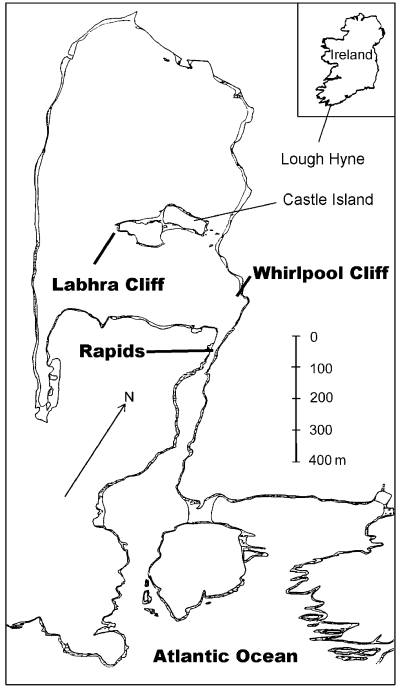
Lough Hyne and location of study sites. Note the very narrow entrance channel at the Rapids.
2. Apparatus and protocol
The artificial substrata used were 15 cm × 15 cm machined slate panels prepared and set up as described by Todd & Turner (1986) and Stanwell-Smith & Barnes (1997). A blue square 10 cm × 10 cm was drawn in the centre of each panel with a permanent blue marker pen. The resulting blue background facilitates the identification of small and/or translucent recruits. Panels were then left in running water for 24 h, dried and the process repeated twice. The panels were attached in sets of three to two pieces of angled steel bars by means of cable ties passing through holes on the panels and the bars. Two panel arrays (6 panels) were positioned blue surfaces down on top of welded steel frames at each depth within each station. Corner bolts on each of the frames were adjusted so the panels were all 20 mm above the underlying substratum. All panels were deployed at the start of October 1997, after which one set was removed a month later (from each station) and replaced with a new set. The other set (from the initial October deployment) was likewise replaced at the start of December 1997, such that panels were immersed for 2 months each, in staggered fashion giving monthly resolution (sensuStanwell-Smith & Barnes, 1997). One failed retrieval of panels resulted in the Whirlpool Cliff and Rapids 6 m panels remaining for three months. Retrieved panels were photographed (in situ), air dried and returned to the laboratory for analysis.
Space coverage by recruits was measured on the central blue square by projecting photographic transparencies of each panel onto a grid of 221 points. The space occupied by each taxon was calculated from the number of points overlain. Such a method has been found to differ insignificantly from calculations of coverage using randomised points (Meese & Tomich, 1992). The number of recruits on each panel surface was counted by eye using a binocular microscope and recorded.
The central blue square on each panel was scanned with a microscope and all contact between individual recruits inspected. Interactions were recorded only if both competitors were alive at the time of contact (i.e. time of collection). Interactions were recorded as overgrowth if the growing edge of one individual (or colony) obscured any feeding apertures of the competitor (as defined by Rubin, 1982; Russ, 1982; Sebens, 1986). Thus the overgrower had ‘won’ one interaction whilst the overgrown was recorded as having ‘lost’ one interaction. Redirected growth or incursions by both competitors was termed a ‘tie’ or ‘standdoff’ (Tanaka & Nandakumar, 1994). Interactions between bryozoans were only recorded if the encounter was frontal (between 330° and 30°) to avoid complications of encounter angle influence (Turner & Todd, 1994). Any instances where an individual removed parts of another competitor were termed ‘undercutting’ (Connell, 1961; Dayton, 1971). Contact matrices were drawn up to sum the species/pair interactions at each station following the methods of Turner & Todd (1994). Recruitment onto the surface of a competitor was not included as an interaction in the matrices.
A two factor General Linear Model was used to compare the number of recruiting taxa (untransformed) between stations and seasons. Chi-square analysis was applied to cheilostomes recruiting on a subset of panels to assess microhabitat preferences. Effect of flow speed on the variables studied was investigated using correlation analysis. Chi-square contingency tests were applied to the interaction matrices for every pair of competitors with the null hypothesis that there was equal probability of wins and losses between each pair of interacting taxa. Where standoffs occurred, the Chi-square test was applied to the total number of winning interactions between the pair. If this figure was significant at P < 0.05 and the number of standoffs was more than the total number of wins then a significant proportion of the interactions was taken to be standoffs (Nandakumar, 1995).
Results
1. Recruitment and space occupation
There were distinct changes in the number of recruits, the space occupied and the number of interactions throughout the year at all investigated sites (Fig. 2, Table 1). There was some evidence of bi-modality of total recruits; although recruitment occurred year-round, all sites showed peaks on panels retrieved in May and September. There was a similar trend in percent cover; spring peaks were owing to mass recruitment of solitary species, principally the barnacles Verruca stroemia at Whirlpool Cliff, Balanus sp. at Rapids and both species plus serpulid polychaetes and the cyclostome bryozoan Tubulipora sp. at Labhra Cliff. The September peaks, in contrast, were largely owing to recruitment of the polychaete Pomatoceros spp. and the bivalve Anomia ephippium. Pomatoceros triqueter and P. lamarkaii were not separated here because they are indistinguishable at tube length < 8 mm (Castric-Fey, 1983). With two exceptions, the seasonal pattern in number of recruitment events paralleled those of space occupation and number of interactions (Fig. 2). The space occupied on the late autumn panels at Labhra Cliff (6 m) was high but the number of colonists was lower than in previous months, as were the interaction numbers. The second exception was summer at the 3 m Rapids station: here, recruitment levels dropped but interaction levels and space occupied remained high.
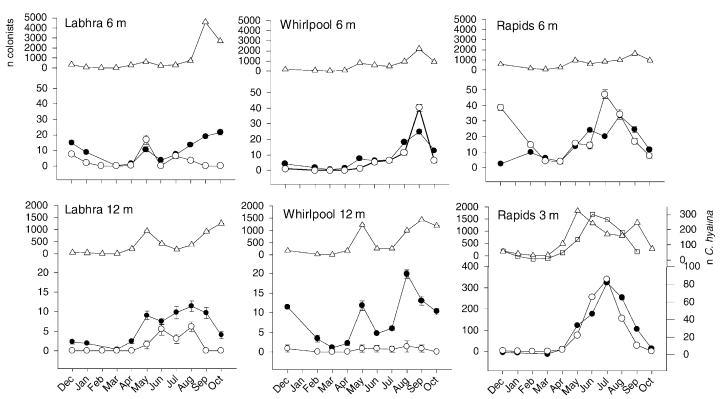
Number of colonists, interactions and percentage cover for panels retrieved in the month plotted (1997/98). All data points have been standardised to 60 days immersion time. Open triangles show number of colonists, open circles show number of interactions and full circles percentage cover. The upper plot for the Rapids 3 m station shows a second axis and the corresponding plot in open squares for the number of Celleporella hyalina colonisers. Points are means for the three panels at each station and Standard Error bars are shown (error bars are very small for upper plots in each case). Note for the Rapids 3 m plots that error bars are too small to be viewed and that the right lower axis is for percentage cover and the left lower axis for number of interactions.
| source | d.f. | adj. SS | adj. MS | F | P |
| station | 5 | 358.793 | 71.759 | 16.95 | < 0.001 |
| date | 10 | 3317.362 | 331.736 | 78.34 | < 0.001 |
| station × date | 50 | 1041.171 | 20.823 | 4.92 | < 0.001 |
| error | 132 | 558.972 | 4.235 |
The ten most numerous species at each station (total recruit numbers over the study period from all panels) are shown in Table 2. The Labhra stations yielded the smallest number of taxa overall. The values on each set of panels varied significantly with station and month (see Table 1), ranging from a low of 12.5 taxa at the Whirlpool 12 m station to a peak of over 19 at the Rapids 6 m station (Table 2). The five most numerous colonising taxa comprised approximately 90 % of the total number of colonists on the Labhra panels. This figure decreased with increasing flow rate to 77 % on at 3 m in Rapids. The smaller community proportion of the five most abundant species at Rapids (compared to the other lower flow sites) indicates that assemblage diversity may be affected by flow rate. Colonial fauna formed a higher proportion of the fauna at sites with high flow rates, accounting for only 2 of the 20 most abundant species at the sheltered Labhra Cliff site (6 and 12 m) compared to half of the 20 most abundant species at Rapids 3 m. Space occupied (r = 0.47, n = 60, P < 0.001) and number of interactions (r = 0.49, n = 63, P < 0.001) significantly increased with increasing flow rate (Fig. 3). The Rapids 3 m data heavily weighted these correlations, but even omitting these data, retained this significant trend in both variables. Number of recruits was not, however, related to flow rate (r = 0.00, n = 63, P > 0.1). Photographs were not obtained for January percent cover, hence lower value of n.
| species | nLabhra12 m | species | n Labhra 6 m | species | nW’pool12 m | species | nW’pool6 m | species | nRapids6 m | species | nRapids3 m |
| Pomatoceros sp. | 6048 | Pomatoceros sp. | 21608 | Anomia ephippium | 7114 | Anomia ephippium | 7263 | Anomia ephippium | 4948 | Semibalanus sp. | 4988 |
| Verruca stroemia | 3315 | Spirorbis sp. | 2515 | Pomatoceros sp. | 4004 | Pomatoceros sp. | 3918 | Microporella ciliata | 4139 | Tubulipora sp. | 3873 |
| Anomia ephippium | 1927 | Anomia ephippium | 1574 | Verruca stroemia | 3479 | Verruca stroemia | 2594 | Tubulipora sp. | 3659 | Celleporella hyalina | 3628 |
| Ascidia sp. | 642 | Tubulipora sp. | 1553 | Balanus sp. | 878 | Tubulipora sp. | 1686 | Pomatoceros sp. | 3596 | Anomia ephippium | 2684 |
| Callopora aurita | 482 | S. scruposa | 684 | Leucosolenia sp. | 710 | C. brongiartii | 540 | Verruca stroemia | 1463 | Microporella ciliata | 2029 |
| Tubulipora sp. | 437 | Balanus sp. | 680 | Filicrisia geniculata | 522 | Spirorbis sp. | 338 | Semibalanus sp. | 1188 | Verruca stroemia | 1834 |
| Semibalanus sp. | 342 | Verruca stroemia | 614 | Tubulipora sp. | 462 | Microporella ciliata | 287 | Spirorbis sp. | 456 | Crisia sp. | 891 |
| Spirorbis sp. | 111 | Callopora aurita | 613 | Crisia sp. | 266 | Aetea sp. | 243 | C. brongiartii | 289 | Pomatoceros sp. | 824 |
| Leucosolenia sp. | 69 | Ascidia sp. | 199 | Microporella ciliata | 123 | Callopora aurita | 209 | Celleporella hyalina | 212 | Spirorbis sp. | 321 |
| Microporella ciliata | 51 | Umbonula ovicellata | 98 | Ascidia sp. | 119 | S. auriculata | 172 | Crisia sp. | 192 | Scruparia chelata | 301 |
| total no. individuals | 13 770 | 30 662 | 18 287 | 18 802 | 21 746 | 22 160 | |||||
| % top 5 | 90.15 | 91.10 | 88.51 | 85.10 | 81.88 | 77.63 | |||||
| % colonial in top 20 | 9.61 | 11.10 | 13.49 | 21.54 | 45.11 | 51.61 | |||||
| mean taxa · month–1 | 15.8 | 17.2 | 12.5 | 18.3 | 19.3 | 15.4 | |||||
| total no. taxa | 40 | 40 | 55 | 61 | 58 | 50 |
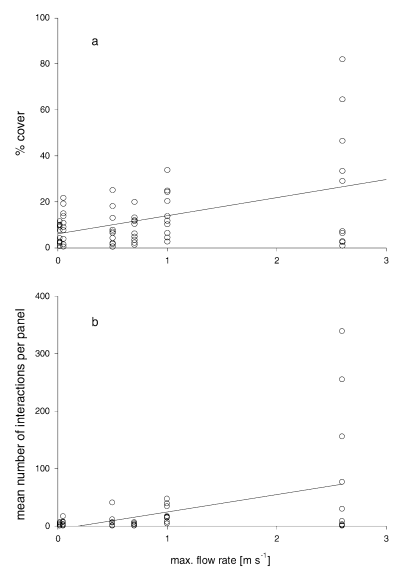
a. Regressions for percentage cover of panels at all sites; all months included. r = 0.47, n = 60, P < 0.001 (r = 0.28, P < 0.05 if weighted R3 station is omitted). b. Regressions for mean number of interactions per panel at all sites. r = 0.49, n = 63, P < 0.001 (r = 0.46, P < 0.01 if Rapids 3 m site omitted). In both cases stations from left to right are Labhra 12 m, Labhra 6 m, Whirlpool 6 m, Whirlpool 12 m, Rapids 6 m and Rapids 3 m.
The peak recruitment numbers were greatest at Labhra Cliff and lowest at Rapids (Fig. 2). The Whirlpool Cliff 12 m station yielded fewer colonists, fewer interactions and lower percentage coverage than might have been expected from comparison with other stations (Fig. 3). The mean total number of taxa (12.5) found on the three panel replicates through the year at the Whirlpool 12 m station is also lower than that of all other stations.
Rubin (1985) suggested that cheilostomatid bryozoans avoid competitive overgrowth by preferentially settling on tubes of Pomatoceros spp. This was tested using Chi-square analysis on the Whirlpool Cliff 6 m September panels, as cheilostomatids were common and serpulids abundant (19.6 % serpulid cover; 75.6 % bare space). Most species showed no significant preference (Table 3), although Membraniporella nitida preferentially settled on serpulid tubes. Three species (Celleporella hyalina, Chorizopora brongiartii and Schizomavella auriculata), however, avoided settlement on serpulid tubes.
| species | number of colonies with ancestrulae on serpulid tube | total number of colonies | χ2 | P | |
| observed | expected | ||||
| Callopora rylandii | 7 | 4.7 | 24 | 1.19 | n. s. |
| Celleporella hyalina | 0 | 4.1 | 21 | 5.77 | < 0.05 |
| Chorizopora brongiartii | 0 | 10.4 | 53 | 14.56 | < 0.01 |
| Escharoides coccinea | 0 | 0.4 | 2 | 0.55 | n. s. |
| Membraniporella nitida | 31 | 16.7 | 85 | 13.98 | < 0.01 |
| Microporella ciliata | 2 | 5.5 | 28 | 3.32 | n. s. |
| Schizomavella linearis | 1 | 1.2 | 6 | 0.07 | n. s. |
| Schizomavella auriculata | 1 | 6.5 | 33 | 6.62 | < 0.05 |
| Bugula sp. | 7 | 4.1 | 21 | 2.24 | n. s. |
| Fenestrulina malusii | 1 | 2.2 | 11 | 0.96 | n. s. |
Different site preferences were recorded for some species, most notably for cheilostomatid bryozoans: a species abundant at one site may be rare or absent at another. Celleporella hyalina was found at the Labhra 12 m station only once and comprised 0.07 % of the total number of cheilostomes there, whereas 3848 colonies of the same species were identified at the Rapids 3 m station (33 % of the cheilostome colonists).
2. Competitive encounters
A total of 3662 interactions were recorded from contact between two individuals/colonies. Most (69.8 %) occurred at the Rapids 3 m station (versus 4.5 % at the sheltered Labhra Cliff site). Most encounters were typical overgrowth interactions, but some were undercutting, where one competitor grew into another and removed parts of it. Undercutting species (Anomia ephippium) thus had high proportions of ‘wins’ when encountering bryozoans (Table 4). Anomia ephippium was therefore omitted from the interaction matrix because of this different type of encounter. Species matrices were analysed for each of the six stations but the low mean levels of cover (6 and 11 % for 12 m and 6 m stations, respectively) and few encounters at Labhra Cliff rendered prohibited a more detailed analysis. The ascidian Ascidia sp. is clearly an overgrowth dominant; it was involved in 50 % of the interactions at Labhra Cliff and won all encounters. Of the 183 interactions recorded at Whirlpool Cliff (both depths) only 3 involved tied outcomes. The assemblage was dominated by decided outcomes although a few were not determinate (i. e. one competitor did not win all interactions against the other). Each matrix presented in Figure 4 was clearly dominated by one species; Celleporella hyalina (Rapids 3 m) and Microporella ciliata (Rapids 6 m). Approximately half the interactions in each matrix were intraspecific: between M. ciliata colonies at Rapids 6 m (95.9 % of intraspecific encounters, 46 % of all encounters) and between C. hyalina colonies at Rapids 3 m (97.8 % of intraspecific encounters, 52 % of all encounters).
| species encountered | number of times observed | undercutting by Anomia | percentage wins for Anomia |
| Aetea sp. | 11 | 11 | 100 |
| Bugula sp. | 2 | 2 | 100 |
| Haplopoma graniferum | 12 | 12 | 100 |
| Chorizopora brongiartii | 5 | 5 | 100 |
| Microporella ciliata | 16 | 14 | 87.5 |
| Celleporella hyalina | 51 | 38 | 74.5 |
| Tubulipora sp. | 9 | 6 | 66.7 |
| Celleporina hassalli | 1 | 0 | 0 |
| Escharoides coccinea | 1 | 0 | 0 |
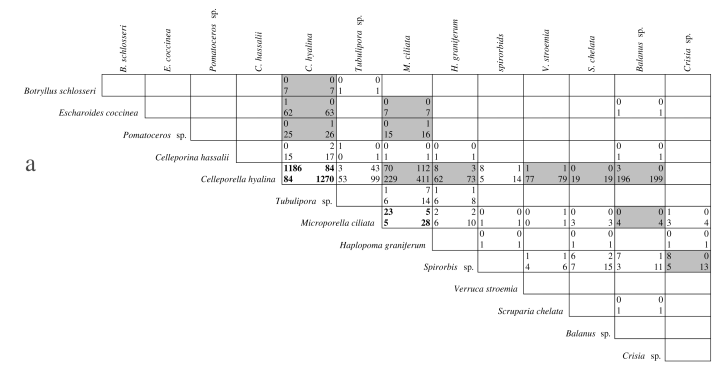
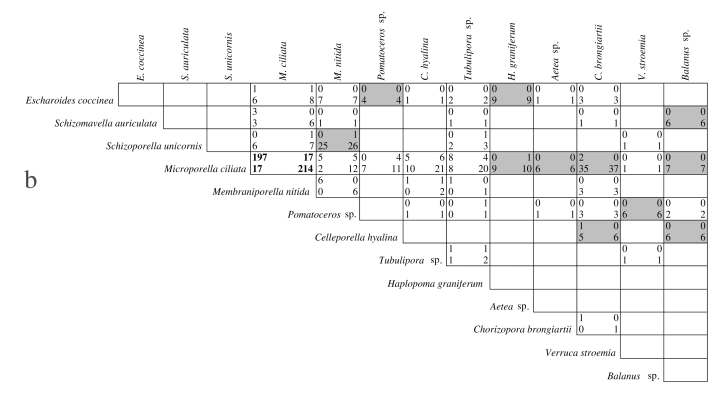
Interaction matrices for the two Rapids stations: a. 3 m and b. 6 m. Each box gives data on interactions between the species at the top of the matrix and the species to the left of the matrix. In each box the data shown are number of ties (upper left), number of wins by species at the top of the matrix (upper right), number of wins by species on the left of the matrix (bottom left) and the total number of interactions (bottom right). Shaded boxes indicate that the species to the left won a significant proportion of interactions (P < 0.05), bold type indicates a significant proportion of standoffs. The presentation follows that of Todd & Turner (1994).
Discussion
1. Recruitment patterns
Distinct seasonality, as found in the present study, has been found to characterise recruitment patterns in most studies of subtidal encrusting communities involving artificial substrata in non-tropical regions (Turner & Todd, 1993; Stanwell-Smith & Barnes, 1997). A different suite of species was evident at each site, most notably for the cheilostomatid bryozoans (Table 2). This may reflect differential preferences for flow speeds which maximise feeding efficiency and growth (McDougall, 1943). Competition between cheilostome species may be important in regulating this observed distribution pattern (Okamura, 1985) and transplant experiments are currently underway to examine growth rates of the different species at each site.
Temperate and tropical panels under conditions similar to the present study typically show 50 % cover after six months and about 90 % cover after one year (Barnes, 1996, and references therein; Stanwell-Smith & Barnes, 1997). Panel colonisation, however, varies widely between sites at similar latitude in Panama due to coastal upwellings (J. B. C. Jackson, pers. comm.). In the present study, percent cover varied more than 2.5 orders of magnitude (0.3 – 82 %) between sites and seasons. The overall mean per cent cover for all sites and seasons was 12.5 %, which is similar to other figures for immersion over a similar time frame (Nandakumar et al., 1993; Barnes, 1996). Clearly, a mean figure from such hugely varying sites does not adequately describe the data set. The extremes of flow that occur in Lough Hyne are rare (especially so close together) in global marine coastal conditions (Kitching et al., 1952).
The significant correlations between flow speed and both percentage cover and number of interactions, together with the insignificant correlation between flow speed and number of recruits, imply that growth rate is higher at high flow sites (Cancino & Hughes, 1987). Larval settlement behaviour was also potentially affected by flow rate (Pawlik & Butman 1993; Abelson 1997), although this is beyond the scope of this article.
Reduced diversity and single species monopolisation has been associated with situations of low physical or biological disturbance (Dayton, 1971; Connell, 1978). A similar situation has been reported in conditions of very high disturbance (Barnes & Clarke, 1998), as predicted by disturbance-diversity theory (Connell, 1978). The mean number of taxa per month (Table 2) suggests higher diversity at the sites of intermediate flow rates, i. e. Rapids 6 m and Whirlpool 6 m (with the Whirlpool 12 m station an apparent anomaly as mentioned earlier). During summer, one species dominated both space and recruits at each Rapids station: Celleporella hyalina at 3 m but Microporella ciliata at 6 m. Given the short distance between sites (Fig. 1) this difference is striking.
2. Interaction patterns
The present study involved end point observations of interactions (see Lopez Gappa, 1989; Turner & Todd, 1994) on seasonal panels and illustrates that the number of interactions generally followed a similar (seasonal) pattern to that of percentage cover and number of recruits (Fig. 2). Intuitively, high recruit numbers and space occupation should lead to more colonists meeting and interacting. As with percentage cover and recruit numbers, there was a significant difference between sites and seasons in terms of the number of interactions (0 to ≥ 300 per 60-day period). The few interactions at the Whirlpool Cliff 12 m station precluded any interpretation of seasonality. The late summer decrease in the number of interactions at the Labhra Cliff 6 m station, despite increased percentage cover and recruit numbers, was the result of Pomatoceros spp. dominating the assemblage. Recruitment and subsequent growth of the serpulid tubes is such that they rarely obstruct feeding apertures (only six intraspecific interactions were observed in this taxon). The other apparently anomalous situation was on the Rapids 3 m panels in July, with a peak in cover and interactions but lower recruit numbers. The cheilostome C. hyalina (the major space occupier) colonised in high numbers and grew rapidly during midsummer (Cancino & Hughes, 1987) and may have curbed settlement of other recruiting species (Nandakumar et al., 1993). This resistance to larval invasion by initial colonists has been shown to be important in regulating community development (Sutherland & Karlson, 1977; Turner & Todd, 1993). The combination of seasonal colonisation (Turner & Todd, 1993; Holmes et al., 1997; Stanwell-Smith & Barnes, 1997) and differential resistance of early colonists to later arrivals means the timing of space availability (the month of immersion in panel experiments) is crucial in determining the community composition (Nandakumar, 1996).
3. Interaction outcomes
Competitor matrices have been widely used to interpret and compare the outcomes of interference competition between encrusting organisms (Russ, 1982; Sebens, 1986; Lopez Gappa, 1989; Turner & Todd, 1994; Barnes & Rothery, 1996). Comparison between sites in the present study was difficult because the number of interactions varied by an order of magnitude. The proportion of tied outcomes was low among interspecific interactions and high among intraspecific interactions confirming results from other localities (Lopez Gappa, 1989; Barnes & Rothery, 1996). Most interactions occurred in the fast-flow Rapids site, and most of these at the shallowest 3 m location. In both cases the most abundant species was a low-ranked competitor. Such single competitor dominance of matrices is unusual, particularly by a poor competitor, but has been reported from a similar high-energy polar site (Barnes & Clarke, 1998). Many intraspecific interactions resulted in standoffs (Fig. 4) and this may be an adaptive competitive strategy for opportunistic species in disturbed habitats (Karlson, 1980; Schmidt & Warner, 1986). Celleporella species are important, and often highly abundant, representatives in frequently disturbed habitats (Lopez Gappa, 1989; Barnes & Rothery, 1996). Cobbles weighing over 200 g can move over one meter within several weeks at the Rapids 6 m station (Maughan, 2000), implying high levels of disturbance.
Note that this study dealt with interactions between early colonists; many typical ‘late successional’ species were simply not observed owing to short panel immersion time. If disturbance within a site such as the Rapids was high enough to preclude the recruitment and development of such species, then early successional species may be more important in regulating community development here than elsewhere. This is supported by the observation that C. hyalina was abundant on boulders and kelp in the highest flow Rapids sites (Kitching & Ebling, 1967).
4. Colonial vs. unitary patterns
Colonial forms dominated the sites with higher flow rate (Table 2), perhaps they tolerate and recover better from disturbance and partial damage (Hughes, 1989; Stanwell-Smith & Barnes, 1997) or have a higher feeding efficiency (McDougall, 1943; Okamura, 1985). Colonial forms often overgrow unitary forms when in direct competition (Jackson, 1979; Grosberg, 1981; Russ, 1982; Sebens, 1986; Nandakumar et al., 1993). Typically, bryozoans are superior overgrowth competitors to polychaetes (Russ, 1982; Sebens, 1986; Barnes & Rothery, 1996). In the present study, however, serpulid worms often overgrew bryozoans. Rubin (1985) suggested that certain cheilostomatid bryozoans settled preferentially on serpulids, using their tubes as secondary space. Such a strategy might also improve competitive ability by raising their height above a competitor (Walters & Wethey, 1986). At Lough Hyne only one cheilostomatid species, Membraniporella nitida, preferentially colonised serpulid tubes, compared to seven found by Rubin (1985). Furthermore, one of the species shown by Rubin (1985) to foul tubes (Chorizopora brongiartii), significantly avoided tubes in this study (Table 1).
The saddle oyster Anomia ephippium was another unitary species that competed successfully for space against colonial forms. In contrast to typical overgrowth encounters, competitive success involved an interaction similar to the undercutting process in barnacles (Connell, 1961). Zooids of bryozoan colonies encountered were generally ruptured by the growing edge of the bivalve. All individuals of this species were under 1 cm diameter in the present study; panels immersed for longer than two months would be needed to investigate whether larger individuals are more successful competitors. The apparent high competitive ability of solitary species is in contrast with previous studies and may reflect short panel immersion times, which preclude the settlement of later successional species that may be better competitors.
Summary
Previous studies on overgrowth in encrusting species have concluded that space must be at a premium for these interactions to be important in community dynamics. Panels in the present study generally had less than 30 % space occupation yet a high number of interactions were recorded (3600). Colonial species with rapid growth rates dominated the sites with higher flow; each station in the Rapids was dominated by one cheilostomatid bryozoan species, which was hence involved in most interactions. Intraspecific standoffs were important at these stations. Preferential settlement on raised surfaces such as serpulid tubes, as reported by previous authors, were rare. Solitary species had unexpectedly high competitive abilities in these communities in early development.
Acknowledgements
Thanks are due to all dive buddies who assisted with the fieldwork, particularly Amy Greenwood. Research was carried out with permission granted by D. O’Donnell (Office of Public Works) and funded by a studentship from the Dept. of Zoology, University College Cork.



